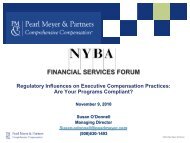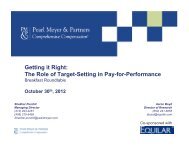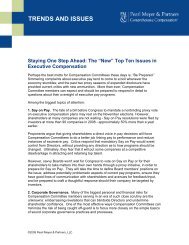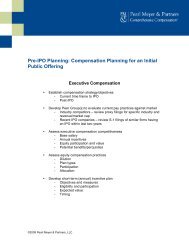IOMA's Complete Guide to Best Practices in Pay-for-Performance
IOMA's Complete Guide to Best Practices in Pay-for-Performance
IOMA's Complete Guide to Best Practices in Pay-for-Performance
You also want an ePaper? Increase the reach of your titles
YUMPU automatically turns print PDFs into web optimized ePapers that Google loves.
IOMA’s COMPLETE GUIDE TO BEST PRACTICES IN PAY-FOR-PERFORMANCE<br />
The best way <strong>to</strong> ensure that your compensation<br />
strategy is “right on the money” is <strong>to</strong> make it a<br />
direct extension of your bus<strong>in</strong>ess strategy, stresses<br />
Jim Hudner, Manag<strong>in</strong>g Direc<strong>to</strong>r at compensation<br />
consultancy Pearl Meyer & Partners (www.pearl<br />
meyer.com). “Compensation is a powerful way <strong>to</strong><br />
communicate messages <strong>to</strong> employees about how<br />
they should conduct themselves on the job. Their<br />
actions and behavior are what drive bus<strong>in</strong>ess results,”<br />
he notes. The way you pay them—and the<br />
th<strong>in</strong>gs you pay them <strong>for</strong>—tells them precisely what<br />
behavior you want <strong>to</strong> see.<br />
“If compensation programs are not l<strong>in</strong>ked with<br />
bus<strong>in</strong>ess strategies, you may discourage the right<br />
behavior—or even encourage the wrong behavior,”<br />
Hudner warns.<br />
Hudner acknowledges that all organizations<br />
struggle <strong>to</strong> make the all-important l<strong>in</strong>k between<br />
bus<strong>in</strong>ess strategy and comp strategy, especially at<br />
the non-executive level. “It is much easier <strong>to</strong> make<br />
a direct connection at the executive level, s<strong>in</strong>ce<br />
senior leaders have the ability <strong>to</strong> make changes<br />
that directly impact the bus<strong>in</strong>ess and the clearest<br />
l<strong>in</strong>e of sight,” he expla<strong>in</strong>s. “At many companies,<br />
however, that impact dim<strong>in</strong>ishes as you move down<br />
<strong>in</strong> the organization.”<br />
Here are Hudner’s recommendations <strong>for</strong> build<strong>in</strong>g<br />
a compensation strategy that is effectively<br />
l<strong>in</strong>ked <strong>to</strong> your bus<strong>in</strong>ess strategy throughout the<br />
organization:<br />
Clearly determ<strong>in</strong>e your bus<strong>in</strong>ess’s competitive<br />
focus. “This starts with the HR/compensation<br />
direc<strong>to</strong>r sitt<strong>in</strong>g down with senior leadership <strong>to</strong> p<strong>in</strong>po<strong>in</strong>t<br />
the basis on which your company is compet<strong>in</strong>g<br />
<strong>in</strong> the marketplace. ‘What is our organization’s<br />
competitive advantage? Why will cus<strong>to</strong>mers use<br />
our goods and services?’” Hudner says.<br />
For example, you may compete primarily on<br />
cost, differentiation <strong>in</strong> the market (<strong>to</strong> appeal <strong>to</strong><br />
mass consumers), cus<strong>to</strong>mer focus (the best service<br />
<strong>in</strong> the bus<strong>in</strong>ess), or reputation with<strong>in</strong> a specific<br />
niche market.<br />
“Your compensation plan needs <strong>to</strong> take those<br />
competitive fac<strong>to</strong>rs <strong>in</strong><strong>to</strong> account first,” Hudner<br />
advises. “For example, if you’re compet<strong>in</strong>g on<br />
cost, us<strong>in</strong>g a 75th percentile pay position<strong>in</strong>g <strong>for</strong><br />
most of your population would conflict with your<br />
bus<strong>in</strong>ess strategy.”<br />
Tip <strong>for</strong> success: “Def<strong>in</strong>e those areas/discipl<strong>in</strong>es<br />
<strong>in</strong> which your organization absolutely must excel <strong>in</strong><br />
order <strong>to</strong> execute your bus<strong>in</strong>ess strategy, whether it<br />
is market<strong>in</strong>g, sales, research, <strong>in</strong>novation, etc. These<br />
are the priority behaviors you need <strong>to</strong> reward,”<br />
Hudner says.<br />
Def<strong>in</strong>e your competitive position vis-à-vis<br />
compensation. “Def<strong>in</strong>e the competitive posture<br />
at which your organization needs <strong>to</strong> compete <strong>for</strong><br />
different segments of the employee population,”<br />
Hudner says. “For example, do you need <strong>to</strong> be at,<br />
below, or above market?<br />
“Also, identify with whom your organization<br />
competes <strong>for</strong> personnel. The talent pool is not<br />
homogeneous <strong>for</strong> most organizations: <strong>for</strong> example,<br />
large, complex health-care organizations compete<br />
<strong>in</strong> a specialized market <strong>for</strong> nurses and medical<br />
technicians, but must vie with general <strong>in</strong>dustry <strong>for</strong><br />
f<strong>in</strong>ance and HR talent.<br />
“You then need <strong>to</strong> determ<strong>in</strong>e how <strong>to</strong> most effectively<br />
allocate your compensation dollars among<br />
base salary, short-term and long-term <strong>in</strong>centives.<br />
For example, asset-management firms tend <strong>to</strong><br />
provide relatively little compensation <strong>in</strong> the <strong>for</strong>m<br />
of base salary as compared with <strong>in</strong>centives, while<br />
at most nonprofit organizations, pay is primarily<br />
delivered <strong>in</strong> base salary,” Hudner po<strong>in</strong>ts out.<br />
Get a good grasp of your corporate culture.<br />
“Have a clear understand<strong>in</strong>g of whether you want<br />
<strong>to</strong> build on your current organization’s current culture,<br />
or use compensation as an agent of change,”<br />
Hudner notes. Compensation should always support<br />
your organization’s desired culture.<br />
Establish which behaviors you want <strong>to</strong> re<strong>in</strong><strong>for</strong>ce.<br />
For example, if your priority is <strong>to</strong> encourage<br />
more teamwork, then your compensation strategy<br />
should be focused on rewards <strong>for</strong> collaboration and<br />
team results, more than <strong>in</strong>dividual per<strong>for</strong>mance.<br />
2 www.ioma.com NOVEMBER 2007









